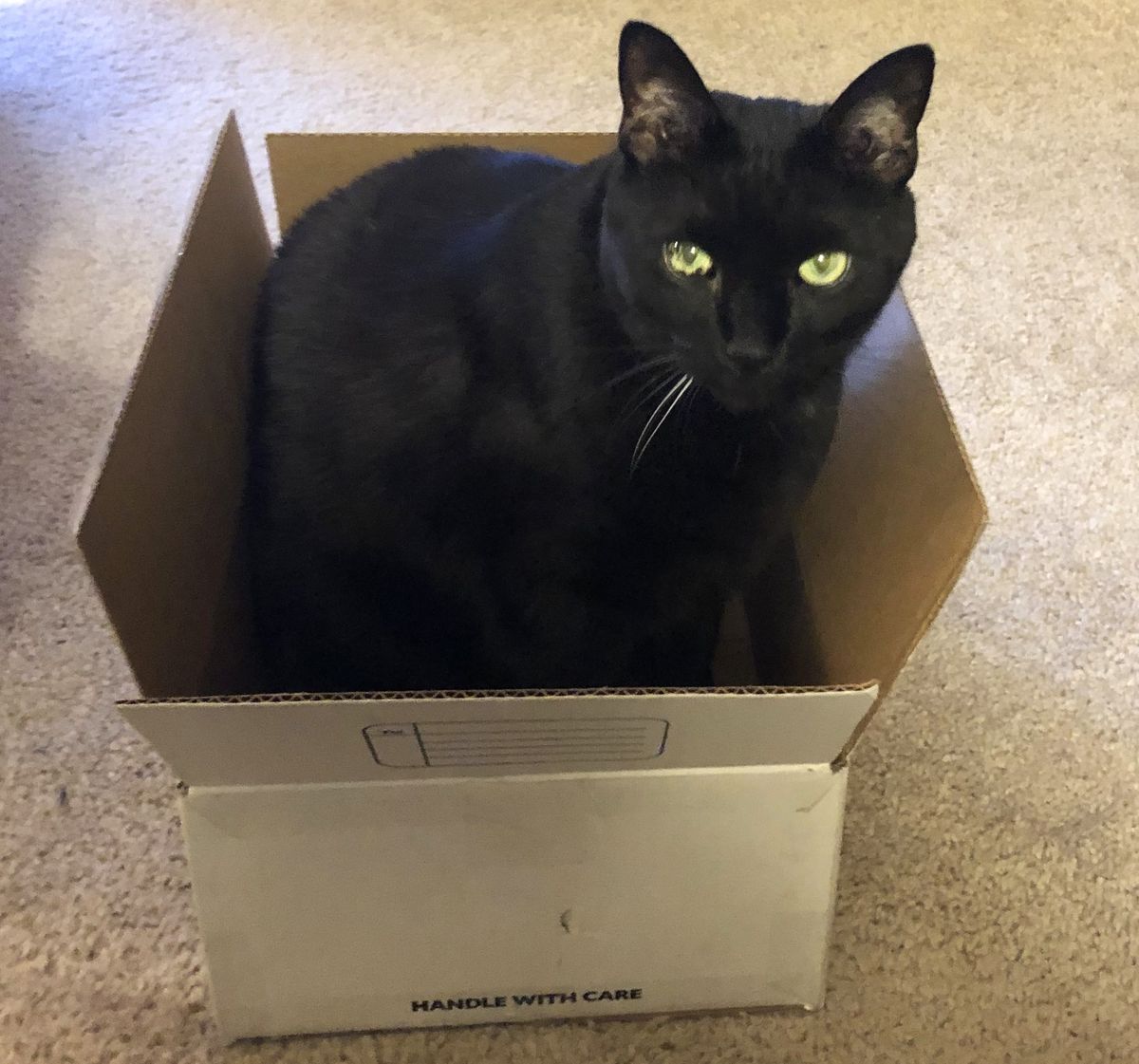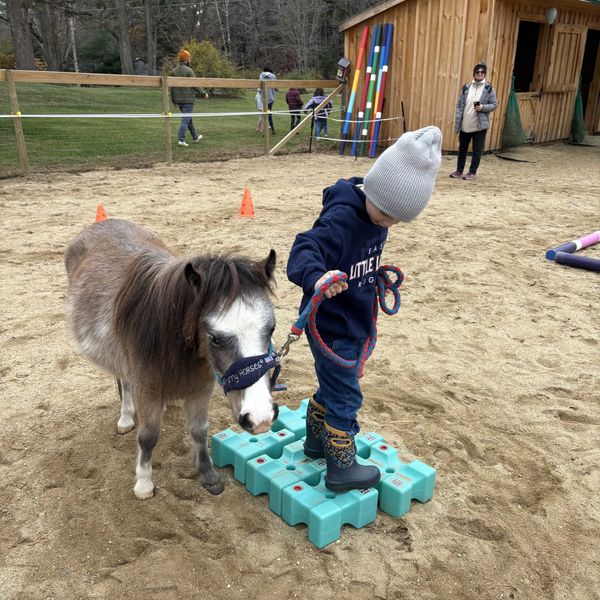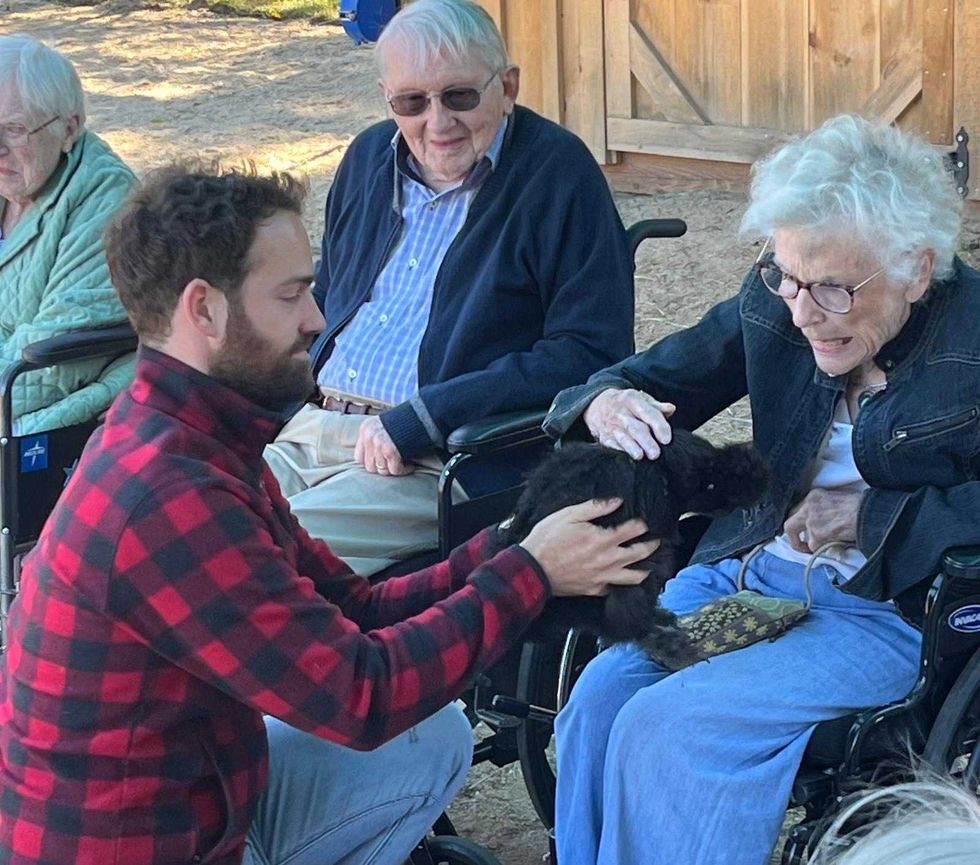Black cats unfairly shunned, stigmatized, say regional animal rescue groups

Lucian picked his owners outside a grocery store.
Provided

Lucian picked his owners outside a grocery store.
Lucian is one lucky black cat. The emerald-eyed feline has been living in the lap of luxury since being rescued from the streets of Albany nine years ago by the Pecha family of Falls Village.
Today Lucian lives in Litchfield with his owner, David Pecha, where he spends his days cat-napping, bird-watching, attention-seeking and occasionally cajoling with a neighborhood fox.
Unlike Lucian, not all black cats end up in forever homes. According to regional animal rescue groups, black pets in general, and black cats in particular, are often shunned by prospective adopters.
Enter National Black Cat Day 2024, which falls on Oct. 27 this year. The annual awareness day is designed to support and promote the beauty and well-being of black cats and to dispel myths and superstitions that have haunted them for centuries, particularly around Halloween.
The day plays a vital role in advocating for welfare and adoption of black cats.
Shunned through no fault of their own
“I’ve had someone come up to me and say they would take anything but black,” said Beverly Ditto of Collaborative Cats, a feline foster home-based rescue organization serving Southern Columbia and Northern Dutchess counties of New York. “There are black cat lovers, but that is rare.”
Ditto, who has owned several black cats, said she has found them to be among the “sweetest and most lovable” of felines, second to orange cats, and not deserving of being feared.
She attributes their lack of popularity to long-held superstitions about them being harbingers of bad luck or that they are evil doers associated with Satanic rituals. Black cats also blend in with shadows, giving them a spooky appearance.
Because superstitions about black cats are reinforced around Halloween, it is common for shelters to put adoptions on hold. According to the Smithsonian, some adoption agencies and shelters won’t even consider placing black cats in homes until after Halloween for fear they will be tortured or sacrificed.
“All the shelters generally are very nervous about adopting out before Halloween,” said Ditto. “There are people out there to be known to harm black cats. I haven’t encountered that, but it has been a big worry amongst the rescues.”
Currently, Collaborative Cats, which takes in stray, abandoned, injured and homeless felines, has several black kittens available for adoption, including Roary, Jacques and Lucifer, all described as sweet and playful.
The organization, which is not a shelter, said Ditto, is constantly seeking new foster homes for its approximately 100 felines.
Raven and Bagheera
At The Little Guild in West Cornwall, two black cats, Raven and Bagheera, arrived at the shelter in August and are awaiting adoption. Both are about a year old and have the sweetest dispositions, said the shelter’s executive director Jenny Langendoerfer.
“It is interesting that people do like to see unique colorings and markings,” she noted. “But the one thing about black cats is that they make the most wonderful pets.”
Langendoerfer described Bagheera, a sturdy, green-eyed young male, as a “mini panther, very silly and very sweet,” and 1-year-old Raven as very playful.
Lauren Mucha, one of the caregivers at The Last Post cat sanctuary and cat retirement home in Falls Village where 124 cats reside, said about 20 of its feline residents are black.
She said she is perplexed as to why people would shy away from dark-coated cats, as they don’t deserve the negative image.
One cat in particular, Jinx, has been a resident at The Last Post for the last eight years and does not have a mean bone in its body, said Mucha, who described him as a Velcro cat, a “real cuddler.”
This cat picked his family
Not everyone is on board with the negative black cat spin. For some, a visit from a black cat means good luck or prosperity. In some cultures, black cats, considered sleek and seductive with their all-knowing yellow and green eyes, are even worshipped.
Take Lucian’s owner, David Pecha, for instance.
The mini household panther was rescued by Pecha’s son, Alex, about nine years ago while attending college in Albany. Alex and a friend had emerged from a grocery store “and the cat came flying out from under a car, meowing at them and trailing them.”
It was the end of the school year, and because the cat appeared to be pretty well cared for, said Pecha, they thought it might have escaped during the confusion of the move.
After failing to find a no-kill shelter nearby, they took Lucian back home with them to Falls Village and posted “cat found” posters around campus, but no one came forth to claim the black cat, said Pecha.
Before long, Lucian befriended a doppelganger named Bagheera, owned by the Atwood family just up the street, Pecha recalled.
“He was the spitting image of Lucian, and they hung out together. You would see the two of them running around the streets in the middle of town.”
When Pecha relocated to Litchfield a few years ago, so did Lucian, who has since settled into his new quarters, according to his owner. He considers his cat to be more like a loyal dog, with a unique personality.
Unlike other cats, Lucian doesn’t use a water bowl. Instead, he laps up his drink from a tall glass, filled with cool water straight from the fridge.
And as for snow, the pampered feline will have nothing of it. “He doesn’t do winter,” said Pecha. “He’ll put one paw in the snow, and it’s ‘Oh, hell no.”
Below are several black cats up for adoption at The Little Guild in West Cornwall, and Collaborative Cats in Ancramdale, NY. Additional details are available by contacting the rescue groups either by phone or via their website. Photos provided.
Willa the Pig lies on a bed of blankets and pillows in her home in Millerton.
MILLERTON — Alanna Broesler didn’t always know she wanted a pet pig. But between watching the movie Babe on repeat as a child and working on a pig farm, the co-owner of Millerton’s farm-to-table restaurant Willa, joked, “there were signs.”
Willa is the restaurant’s namesake — a 130-pound house pig who loves smoothies, snuggling and sassing her family. She is a potbellied and Juliana cross with big spots and a big personality to match.
“Willa has always been a very dominant, kind of cheeky pig,” Broesler said with a laugh. “She’s very vocal.” Willa walks around her Millerton house with confidence and lots of opinions, especially when smoothies are involved. The first rumble of ice, or even the mention of the word “smoothie,” will cause Willa to jolt up from her cozy bed of pillows to investigate the scene. Her favorite blend is oat milk, yogurt and banana.
Broesler brought the pig home in 2017 and named her after legendary country singer Willie Nelson. Broesler said she was young at the time, unsure where she would be living, and uneducated about keeping pigs in a house. But after meeting Willa she knew that she wanted to give her a home.
“Looking back, it was irresponsible,” said Broesler — not necessarily because of the circumstances, but because she acquired Willa through a breeder. As she immersed herself in the pig community, Broesler learned about the demand for pig adoption. “Potbellied pigs are constantly getting rehomed and they need stable placements,” she said.
Enter Milo – Willa’s new baby brother. Milo is all black with a bottle-brush tail. His nose is flatter than Willa’s, and he has tusks. Broeslder adopted Milo and rescued him from a “horrible situation,” she said. He was kept in a crate and lacked proper care and affection.
Today, Milo’s favorite activity is grazing in the fenced-in section of Broesler’s yard. Quieter than his older sister — who runs the show, which also includes three cats and two chinchillas —Milo is getting used to home life with free space and loving caretakers.
Broesler didn’t come from a farming background. Her family owns a traditional Irish pub in New York State where she developed a strong work ethic and firsthand knowledge of the service industry. “I’ve been scrubbing potatoes and sweeping sidewalks for as long as I can remember,” Broesler said with a laugh.
But when it came time to apply for college, Broesler knew exactly what her future looked like.
“I always knew I wanted to work outside and with animals,” Broesler said. She sought out as much experience as she could. She milked goats, worked on cattle farms, and grew vegetables and flowers. What stands out vividly is working with pigs. Ultimately, all of her experience led to a farm-to-table restaurant.
But as the restaurant becomes more established a new dream is beginning to take shape. Broesler has just completed paperwork to establish her own pig sanctuary — Willa’s Way — a 501(c)(3) nonprofit.
Though in the preliminary stages, Broesler excitedly describes an elaborate vision. As a destination spot, the sanctuary would add value to the community in myriad ways, incorporating farm-fresh eggs, native flowers, in-season vegetables and educational opportunities related to sustainability.
At its core, the pig sanctuary would be in service of the animals. It would support rehabilitation, rehoming or placement, public education, and simply letting older pigs live out their remaining days with love and care.
“The most common question I get is, ‘Where would we be rescuing the pigs from,’” said Broesler. “People don’t often realize how huge the need is because of bad breeders, hoarding cases, or bad characters who lie about micropigs or teacup pigs, claiming they’ll remain 25 pounds.”
She adds that adopting Milo lit the fire for the sanctuary idea. “To watch him come to me as a sick, malnourished, really sad pig and come out of his shell with a funny personality – and he’s getting healthy and feeling good – it’s just been the best thing.”
The next steps for the sanctuary are to identify investors, apply for grants, and acquire 30 to 50 acres of land. No small feat, but Broesler is up for the challenge.
Halloween marked the two-year anniversary since Willa opened its doors on Main Street. With a menu that is, of course, pork free, Executive Chef Daniel Meissner has created imaginative farm-to-table offerings that change with the seasons.
“He has such a passion for cooking locally and supporting farmers,” said Broesler. “And he shows people that you can eat seasonally and it can taste amazing.”
The restaurant now works with approximately 20 local farms and vendors, including Thistle Pass, Kinderhook Farm, Harlem Valley Homestead and Off the Shelf Farm, to name a few. Menu items often include nods to farmers by name – a subtle way to spark conversations and celebrate the region’s producers, Broesler said.
When customers come into the restaurant, they often mistake Broesler for “Willa.” She corrects them with a laugh. “No, Willa is a very spoiled potbellied housepig.”
Anthony Musso discusses his book “Hidden Treasures of the Hudson Valley” at the North East Historical Society’s annual meeting on Saturday, Nov. 15. The book centers on historical sites across the region with rich backgrounds and low ticket-prices for maximum accessbility.
MILLERTON — With his signature Brooklyn accent, sense of humor and wealth of knowledge, author and historian Anthony “Tony” Musso brought American Revolution history to life at the NorthEast-Millerton Library Annex in partnership with the North East Historical Society.
The talk marked Musso’s first speaking engagement at the Annex and coincided with the historical society’s annual meeting.
Musso guided attendees through an oral tour shaped by excerpts from his three-volume series, “Hidden Treasures of the Hudson Valley,” which together highlight 165 local historical sites that are rich in history and light on the wallet. Each book features 55 locations that are open to the public.
“I included places that fly under the tourists’ radar,” said Musso, addressing the crowd of more than 30 attendees. “Many of them are run by historical societies, so the added benefit is a free or nominal charge.”
His presentation began with Pawling’s Quaker Hill, where in 1740 a group of Quakers petitioned the Religious Society of Friends to build their own meeting house so they wouldn’t have to travel elsewhere to go to Sunday worship.
“It was kind of small,” Musso remarked of the original structure. “They ran into a problem within the first five years because they had so many people standing around, they couldn’t all get inside.” As a result, in 1767 the Quakers got permission to build a bigger meeting house just across the street.
“This one was a two-story structure with a wrap-around balcony where they could fit everybody inside.” Musso described an event in 1778 during a regular Sunday worship when three officers from the Continental Army came into the meeting house, sat respectfully in the back, and when the service came to a close they announced that they were going to commandeer the building.
“Nearby, George Washington led a large encampment of troops and they wanted to have this building be used as a medical hospital,” Musso said.
During the army’s occupation, the makeshift hospital was overseen by Dr. James Fallon, and many people referred to it as “Fallon’s Hospital.” Approximately 100 troops were treated there throughout its four months of winter operation.
“If you know anything about Quaker beliefs, pacifism is right at the top,” said Musso. “And although the military was not putting armament, cannons or munition in the building — it was for a humanitarian purpose — the Quakers abandoned the building as long as the army was there and found another building down the hillside.”
The Quakers also refused to provide the army with provisions, Musso said, which exacerbated harsh conditions that winter.
When the army left, the Quakers returned to the building and continued with their meetings and worship. Musso added that in 1932, the meeting house was acquired by the historical society of Quaker Hill and Pawling, and “that’s why the building is in such meticulous shape today.”
Musso went on to explain that while George Washington never stayed at encampment with his troops, he did commandeer a house for four months down the hill in the village of Pawling — the home of John Kane, who was originally a Patriot at the start of the American Revolution but switched sides and became a Loyalist.
From there, Musso expanded the tour to Westchester and Rockland counties, including the location where Benedict Arnold turned over the plans, layout and staffing for Fort Arnold to British spy John André — and the site where Andre was subsequently hanged.
As a seasoned historian, speaker and guide, Musso shared one of his tricks if he ever feels like his audience is losing interest. He brings up Hamilton the musical. “I don’t lie to people,” he jokes, “but I say, ‘I can’t prove this, but I’ve heard that some of the music from Hamilton was written here.’”
Though Musso didn’t delve into the rich history of North East’s Coleman Station during the presentation, Musso said it is one of the sites included in his books.
Musso has lived in LaGrange for 40 years, and his career has spanned decades at the post office, writing for the Poughkeepsie Journal, and authoring numerous nonfiction books. “I love the history of this area, and I’m not going to stop telling it anytime soon.”
North East Historical Society annual meeting
Other business from the North East Historical Society included acknowledgements of board members and volunteers. President Ed Downey expressed gratitude for the society’s partnership with the NorthEast-Millerton Library, noted that four members are up for re-election and shared that membership has increased by 54% over the last decade, now totaling 179 — among the highest of any historical society in Dutchess County.
Downey also highlighted ongoing digitization efforts, saying the goal is to “digitize and publish” the historic Millerton Telegram and 90 years of The Millerton News. Downey added that this is a costly project and relies heavily on donations to sustain the work.
“Once Upon a Time in America” features ten portraits by artist Katro Storm.
The Kearcher-Monsell Gallery at Housatonic Valley Regional High School in Falls Village is once again host to a wonderful student-curated exhibition. “Once Upon a Time in America,” ten portraits by New Haven artist Katro Storm, opened on Nov. 20 and will run through the end of the year.
“This is our first show of the year,” said senior student Alex Wilbur, the current head intern who oversees the student-run gallery. “I inherited the position last year from Elinor Wolgemuth. It’s been really amazing to take charge and see this through.”
Part of what became a capstone project for Wolgemuth, she left behind a comprehensive guide to help future student interns manage the gallery effectively. “Everything from who we should contact, the steps to take for everything, our donors,” Wilbur said. “It’s really extensive and it’s been a huge help.”
Art teacher Lilly Rand Barnett first met Storm a few years ago through his ICEHOUSE Project Space exhibition in Sharon, “Will It Grow in Sharon?” in which he planted cotton and tobacco as part of an exploration of ancestral heritage.
“And the plants did grow,” said Barnett. She asked Storm if her students could use them, and the resulting work became a project for that year’s Troutbeck Symposium, the annual student-led event in Amenia that uncovers little-known or under-told histories of marginalized communities, particularly BIPOC histories.
Last spring, Rand emailed to ask if Storm would consider a solo show at HVRHS. He agreed.
And just a few weeks ago, he arrived — paints, brushes and canvases in tow.
“When Katro came to start hanging everything, he took up a mini art residency in Ms. Rand’s room,” Wilbur said. “All her students were able to see his process and talk to him. It was great working with him.”
Perhaps more unexpected was his openness. “He really trusted us as curators and visionaries,” Wilbur said. “He said, ‘Do with it what you will.’”

Storm’s artistic training began at New Haven’s Educational Center for the Arts. His talent earned him a full scholarship to the Arts Institute of Boston, then Boston’s Museum School, where he painted seven oversized portraits of influential Black figures — in seven days — for his final project. Those works became the backbone of his early exhibitions, including at Howard University’s National Council for the Arts.
Storm has created several community murals like the 2009 READ Mural featuring local heroes, and several literacy and wellness murals at the Stetson Branch Library in New Haven. Today, he teaches and works, he said, “wherever I set up shop. Sometimes I go outside. Sometimes I’m on top of roofs. Wherever it is, I get the job done.”
His deep ties to education made a high school gallery an especially meaningful stop. “No one really knew who these people were except maybe John Lennon,” Storm said of the portraits in the show. “It’s really important for them to know James Baldwin and Shirley Chisholm. And now they do.”
The exhibition includes a wide list of subjects: James Baldwin, Shirley Chisholm, Redd Foxx, Jasper Johns, Marilyn Manson, William F. Buckley, Harold Hunter, John Lennon, as well as two deeply personal works — a portrait of Tracy Sherrod (“She’s a friend of mine… She had an interesting hairdo”) and a tribute to his late friend Nes Rivera. “Most of the time I choose my subjects because there are things I want to see,” Storm said.
Storm’s paintings, which he describes as “full frontal figuratism,” rely on drips, tonal shifts, and what feels like emerging depth. His process moves quickly. “It depends on how fast it needs to get done,” he said. “Sometimes I like to take the long way up the mountain. Instead of doing an outline, I just start coloring, blocking things off with light and dark until it starts to take shape.”
He’s currently in a black-and-white phase. “Right now, I’m inspired by black and white, the way I can really get contrast and depth.”
Work happens on multiple canvases at once. “Sometimes I’ll have five paintings going on at one time because I go through different moods, and then there’s the way the light hits,” he said. “It’s kind of like cooking. You’ve got a couple things going at once, a couple things cooking, and you just try to reach that deadline.”
For Wilbur, who has studied studio arts “ever since I was really young” and recently applied early decision to Vassar, the experience has been transformative. For Storm — an artist who built an early career painting seven portraits in seven days and has turned New York’s subway corridors into a makeshift museum — it has been another chance to merge artmaking with education, and to pass a torch to a new generation of curators.
Le Petit Ranch offers animal-assisted therapy and learning programs for children and seniors in Sheffield.
Le Petit Ranch, a nonprofit offering animal-assisted therapy and learning programs, opened in April at 147 Bears Den Road in Sheffield. Founded by Marjorie Borreda, the center provides programs for children, families and seniors using miniature horses, rescued greyhounds, guinea pigs and chickens.
Borreda, who moved to Sheffield with her husband, Mitch Moulton, and their two children to be closer to his family, has transformed her longtime love of animals into her career. She completed certifications in animal-assisted therapy and coaching in 2023, along with coursework in psychiatry, psychology, literacy and veterinary skills.
Le Petit Ranch operates out of two small structures next to the family’s home: a one-room schoolhouse for animal-assisted learning sessions and a compact stable for the three miniature horses, Mini Mac, Rocket and Miso. Other partner animals include two rescued Spanish greyhounds, Yayi and Ronya; four guinea pigs and a flock of chickens.
Borreda offers programs at the Scoville Library in Salisbury, at Salisbury Central School and surrounding towns to support those who benefit from non-traditional learning environments.
“Animal-assisted education partners with animals to support learning in math, reading, writing, language and physical education,” she said. One activity, equimotricité, has children lead miniature horses through obstacle courses to build autonomy, confidence and motor skills.

She also brings her greyhounds into schools for a “min vet clinic,” a workshop that turns lessons on dog biology and measuring skills into hands-on, movement-based learning. A separate dog-bite prevention workshop teaches children how to read canine body language and respond calmly.
Parents and teachers report strong results. More than 90% of parents observed greater empathy, reduced anxiety, increased self-confidence and improved communication and cooperation in their children, and every parent said animal-assisted education made school more enjoyable — with many calling it “the highlight of their week.”

Le Petit Ranch also serves seniors, including nursing home residents experiencing depression, social withdrawal or reduced physical activity. Weekly small-group sessions with animals can stimulate cognitive function and improve motor skills, balance and mobility.
Families can visit Le Petit Ranch for animal- assisted afterschool sessions, Frech immersion or family walks. She also offers programs for schools, libraries, community centers, churches, senior centers and nursing homes.
For more information, email info@lepetitranch.com, visit lepetitranch.com, follow @le.petit.ranch on Instagram or call 413-200-8081.